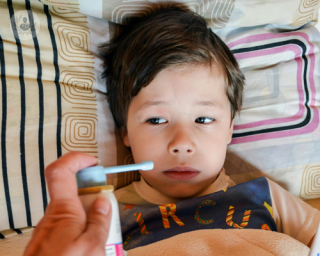The common cold
Dr Amandeep Singh Grewal - GP (general practitioner)
Created on: 08-07-2019
Updated on: 10-10-2023
Edited by: Kate Forristal
What is the common cold?
The common cold, which is often referred to simply as a cold, is a viral disease of the upper respiratory tract, affecting the nose, throat and sinuses. It is the most frequent infectious disease among humans.
There are over 200 strains of the cold virus with around 50 percent being rhinoviruses. A rhinovirus is a type of virus that grows in temperatures of 33-35 °C - the temperatures found in the nose. They are spread by the transmission of virus-infected airborne droplets as well as by direct contact with infected secretions.

Condition prognosis
Normally, the prognosis for the common cold is extremely good. The virus generally runs its course and people often recover after seven to ten days. Some less common forms of the virus can take a few weeks to completely resolve.
In very rare occasions, especially in elderly people, the common cold can trigger more serious complications such as influenza, pneumonia and bronchitis if left untreated. Therefore, it’s advisable to seek medical attention if you are over 65 or have an underlying medical health problem.
What are the symptoms?
The most common symptoms of the common cold include:
- Cough
- Sore throat
- Sneezing and a running nose
- Nasal congestion
- Mild headache
- Hoarse voice
- Mild fever
Sometimes, the virus can cause a person to experience muscle ache, loss of appetite, severe headache and fatigue, but these are usually less common.
Diagnosis
Most of the time, a visit to the doctor isn’t necessary and a person can diagnose a cold simply from the symptoms that are present. However, if the symptoms are very severe or persistent then a doctor’s diagnosis might be needed.
Causes
The cold virus can enter your body through your nose, mouth or eyes. It is spread when an infected person sneezes or coughs in your close environment. It can also be spread by hand-to-hand contact with someone who has a cold or by sharing contaminated objects.
When a virus enters and overpowers the immune system, the infection begins. The production of mucus, which is produced in the nose and throat, is the body’s first line of defence against viruses. These viruses multiply in the mucus and start attacking surrounding cells.
It is a common myth that being cold for a long time can cause a cold. While some viruses are more present in the winter season, cold weather encourages close contact between people which therefore promotes the easy spread of the virus during the winter period.
How to avoid catching and spreading the common cold
There are many precautions you can take to reduce the chance of the cold virus spreading. These include:
- Avoiding close contact with someone who has a cold.
- Washing your hands regularly.
- Eating enough vitamin-rich fruit and vegetables to keep the immune system strong.
- If you already have a cold, preventing the spread of it is very important, especially for those around you. If you have a cold, doing the following can help to avoid spreading it to others:
- Coughing or sneezing into a tissue, discarding it and washing your hands.
- If you don’t have a tissue, cough into your hands and wash them thoroughly afterwards.
- Avoiding close contact with other people until symptoms disappear.
Treatments
There is no cure for the common cold and treatment is directed around relieving the symptoms until the virus passes. The following measures can help to relieve the symptoms:
- Drink plenty of fluids to keep your body hydrated
- Get lots of bed rest so the immune system can fight off the virus
- Take pain relievers such as aspirin, ibuprofen and paracetamol
- Purchase decongestant nasal sprays to help relieve a blocked nose
- Buy over-the-counter cough syrups to relieve a cough, especially if it is preventing a good night’s sleep









